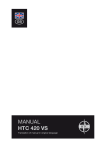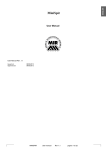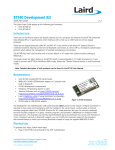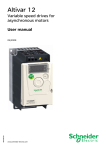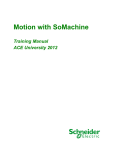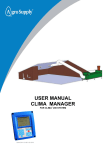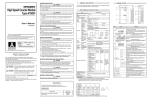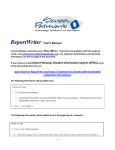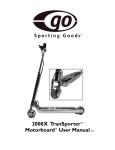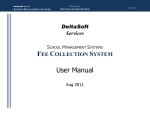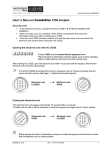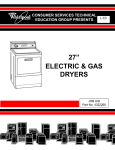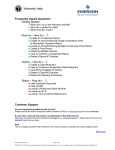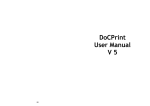Download Instructions
Transcript
H-2957 AUTOMATIC STRETCH WRAP DISPENSER SYSTem specifications MACHINE DIMENSIONS •Adjustable raise and lower speeds •Automatic height detection photoelectric sensor Length 116" Width 65" Height 92" •¼ HP 3-phase AC motor, ½ HP AC frequency drive Turntable Diameter 65" •Adjustable film force Turntable Height from Floor 3 1/4" •200% / 250% average pre-stretch level Wrapping Height 80" •10" diameter roll capacity Operation Space 125 x 70 x 100" •20" height roll capacity Maximum Load Size 56 x 56 x 80" Approximate Shipping Weight 1220 lbs ELECTRICAL SPECIFICATIONS •120 VAC, 60 Hz, Single-phase, 15 AMP •NEMA-12 rated electrical panel •Operating temperature: +32˚F to +110˚F •Lockable disconnect switch •NEC wiring standard •Programmable Logic Controller (PLC) with input/ output diagnostic lights TURNTABLE SYSTEM •Low Profile: ½ HP 3-phase AC motor, ½ HP AC frequency drive •20-30 loads per hour (spiral) •12 RPM turntable maximum speed •4,000 lbs turntable maximum load capacity FILM CARRIAGE / ELEVATOR SYSTEM •½ HP 3-phase AC motor, ½ HP AC frequency drive PAGE 1 OF 17 FILM DELIVERY SYSTEM CAUTION! Motor control equipment and electronic controllers are connected to hazardous line voltages. When servicing drive and controllers, there may be exposed components with housings or protrusions at or above line potential. Extreme care should be taken to protect against shock. The user is responsible for conforming to all applicable code requirements with respect to grounding all requirements. Do NOT use extension cords to operate the equipment. Disconnect AC input power before checking components, performing maintenance, cleaning up, and when the machine is not in use. Do NOT connect or disconnect wires and connectors while power is applied to circuit. Wiring work should be carried out only by qualified personnel. There is a danger of electric shock or fire. WARNING! Loose clothing must NOT be worn while the machine is in operation. Stay clear of moving parts while the machine is running. 0411 IH-2957 SYSTem description Tower Control Box Stretch Selector Cover Photo Sensor Motor Cover Film Carriage Frame Turntable Foot Security Pan Auto Film Cut Solenoid NOTE: Shown below are STANDARD assembly drawings. It may not reflect your purchased system, especially when optional items are added. Refer to assembly drawings shipped inside the electrical enclosure for more detail information. 3.25" 92" Machine Height 80" Wrapping Height 101.5" Machine Length 35.5" 65" Turntable Size 41" 12.5" 8" " 10 PAGE 2 OF 17 0411 IH-2957 SYSTEM SET-UP MACHINE PLACEMENT Power and Safety Wiring Checks Place the Automatic Stretch Wrap Machine close to an area where you will be wrapping your pallet loads. Make sure that there is sufficient room to load/unload the machine and that you do not stretch the wiring cable. Remember, you will need to provide electrical service to a 120 VAC, 15-AMP outlet. 1. Using a voltage meter, check the AC voltage coming to the system to insure proper voltage is present. Floor weight bearing tolerance The floor must be able to bear the weight of the machine, the weight of the maximum load, plus a safety factor. The floor must also be able to tolerate the stress of the machine’s operation. If the fork trucks will operate on the same weight bearing area, add the weight of the trucks to the weight bearing stress tolerance requirements. WARNING! The Stretch Wrap Machine must be anchored securely to the floor, using the type of anchor recommended for your floor. MACHINE SET-UP 1. Place skidded machine close to the designated wrap area. Remove all shipping fasteners holding the machine to the pallet. The machine may be crated with the tower tilted down with the motor cover front carriage roller removed for shipping purpose. 2. Place forks of the forklift through the tubes provided at the rear base of the module, remove the machine from these skids, and place it at the designated wrap area. 3. If the optional ramp (H-2958) is purchased: Select a ramp position as illustrated below. The ramp can be positioned anywhere in a 180° rotation around the front of the turntable. There should be a ¼" gap between the turntable and the ramp. The ramp should be fully supported by the floor. Both the ramp and the machine should be lagged to the floor. 2. Make sure the "E-STOP" button is pressed in. Turn the disconnect switch to ON position. 3. Pull the "E-STOP" button on the operator panel out. Power should be applied to the frequency drives, operating touch-panel, photoelectric sensors, switches, and LED’s. 4. Press the "E-STOP" button. Make sure all machine power is completely removed when the "E-STOP" is depressed. Pull the "E-STOP" button out to resume. 5. Open the film carriage door. Make sure all machine power is completely removed when the carriage door is open. Close the film carriage door to resume. 6. Open the electrical control box. Make sure all machine power is completely removed when the electrical control box is open. Close the electrical control box to resume. 7. Trip the carriage foot security bar. Make sure all machine power is completely removed when the carriage foot security bar is tripped. Clear the bar to resume. PLC's Input Module Checks 1. Open the electrical control box, and insert the key latch onto the safety door switch. 2. Depress push buttons and activate selector switches on the operator panel, check for each corresponding input lights on the front face of PLC. 3. Block the "Product Height Detection" photoelectric sensor (located on the film carriage), check for corresponding input light on the front face of PLC. 4. Trigger magnetic proximity and limit switch sensors, check each corresponding input lights on the front face of the PLC. WARNING! Do NOT remove or modify the fixed upper and lower limit switch stops. ¼" Gap 5. Remove the key latch, and close the electrical control box to resume. 180˚ PAGE 3 OF 17 0411 IH-2957 PRE-STRETCH ADJUSTMENT Pre-Stretch Percentage Change To change the pre-stretch percentage, follow the procedure below: 1. Turn the main disconnect switch off. 2. Remove the knob cover on the film carriage. 4. To ensure safety and correct operation of the stretch gears, check the following items: a) The safety line is back to its home position following the profile of the knob. Safety Line Safety Lock b) The light indicates the selected pre-stretch percentage. High Ratio 3. Push the safety lock and slide the knob to change the pre-stretch percentage. Lift the knob for the high percentage, or lower the knob for low percentage. Standard percentages are 200% (low) and 250% (high). Low Ratio High-Ratio Safety Lock PAGE 4 OF 17 Low-Ratio 0411 IH-2957 FREQUENCY DRIVE An electronic frequency motor drive is a device that controls the 3-phase AC induction motor’s speed by varying the frequency of the power sent to the motor. The Predator Turntable Stretch Wrapper uses Schneider Electrical Altivar 12 Adjustable Frequency Drives. 7. Jog dial Altivar 12 Digital Keypad Description 8. MODE button The digital keypad includes the displays panel and the keypad. The display panel provides the parameter display and shows the operation status of the AC drive. The keypad provides programming and control interface. Description: 1. Value LED (a) (b) 2. Charge LED - For navigation when turned clockwise or counterclockwise - and selection / validation when pushed Switches between the control/programming modes. The MODE button is only accessible with the HMI door open. 9. CONFIGURATION mode LED (b) 10.MONITORING mode LED 11.REFERENCE mode LED 12.Four "7-segment" displays 3. Unit LED (c) (a) If illuminated, indicates that a value is displayed, for example, 0.5 is displayed for "0.5". 4. ESC button: Exits a menu or parameter, or aborts the displayed value to return to the previous value in the memory. (b) When changing a value the configuration mode LED and the value LED are on steady. 5. STOP button: Stops the motor (could be hidden by door if function disabled). Important: See instructions for "RUN/STOP" cover removal. (c) If illuminated, indicates that a unit is displayed, for example, AMP is displayed for "Amps". 6. RUN button: Starts running if the function is configured (could be hidden by door if function disabled). PAGE 5 OF 17 0411 IH-2957 FREQUENCY DRIVE CONTINUED Menu Structure To access the monitoring parameters, press the wheel on the face of the frequency drive. Using the wheel, scroll through the list until the display shows Non (Mon) for monitoring mode. This gives the user access to all the monitoring parameters. To access the complete set of drive parameters first press the wheel to access different modes. Using the wheel, scroll to "COnF" and press the wheel again; this will access different sets of parameters. Using the wheel, scroll to "FULL" and press the wheel; this will give the user access to the complete parameter set. ENT Monitoring Parameters CODE NAME/DESCRIPTION UNIT LFr External Reference Value: External keypad or local force mode configured. Forced local reference FLOC set to LCC and forced local assignment FLO different to nO. Displays the speed reference coming from the remote keypad. This value is not visible in factory setting. Hz rFr Output Frequency: This function provides the estimated motor speed. It corresponds to the estimated motor frequency (on the motor shaft). In standard law the output frequency rFr is equal to stator frequency. In performance law the output frequency rFr motor speed is equal to the estimated motor speed. Range: -400 to 400 Hz Hz LCr Motor Current: Estimation of the effective motor current from phase current measurements with an accuracy of 5%. During DC injection, the current displayed is the maximum value of current injected in the motor. A ULn Main Voltage: Line voltage from the point of view of the DC bus, motor running or stopped. A CODE StAt NAME/DESCRIPTION ß Product Status This parameter shows the state of the drive and motor. rdY rUn ACC dEc dCb CLl nSt Obr CtL tUn FSt nLP PAGE 6 OF 17 ß ß ß ß ß ß ß ß ß ß ß ß Drive ready. Drive running, the last six segments to the right of the code also indicate direction and speed. Acceleration, the last six segments to the right of the code also indicate direction and speed. Deceleration, the last six segments to the right of the code also indicate direction and speed. DC injection braking in progress. Current limit, the four segments located on right down of display are blinking. Freewheel stop control. Auto-adapted deceleration. Controlled stop on mains phase loss. Auto-tuning in progress. Fast stop. No line power. When the control part is energized via the RJ45 connector and there is no power on the main input and no run order is present. 0411 IH-2957 FREQUENCY DRIVE CONTINUED Programmable Functions All functions have been Highlight factory set and tested. The factory settings listed in this manual are the drive manufacturer's factory setting, not the Highlight Industries factory settings. Refer to the Electrical Schematic Drive Parameters page for the Highlight factory settings. Some of the most commonly adjusted programmable functions (parameters) are listed below: NOTE: Refer to the manufacturer's operation manual or website for complete lists and explanations. I_O MenU CODE SUBCODE tCC Al1- factory setting Type of Control: 2C – 2-wire control 3C – 3-wire control 2C Analog Input 1 Type: 5U – 0-5VDC input voltage 10U – 0-10VDC input voltage 0A – 0-20mA current input 5U Relay Output 1 Assignment: nO – Not assigned FLt – No error detected rUn – Drive run FLt AO1 Analog Output 1 Assignment: nO – Not Assigned OCr – Motor current OFr – Output Frequency nO AO1t Analog Output 1 Type: 10U – 0-10VDC 0A – 0-20mA 4A – 4-20mA 0A Al1t r1 AO1- NAME/DESCRIPTION drC MENU CODE SUBCODE NAME/DESCRIPTION Adjustment raNge factory setting bFr Standard Motor Frequency 50/60 50Hz nPr Rated Motor Power (% of drive rated HP) 0.5-1.2 1 UnS Rated Motor Voltage 100-480V 230V nCr Rated Motor Current plate Varies FrS Rated Motor Frequency 10-400Hz 50 Hz nSP Rated Motor Speed 0-24000rpM Varies tFr Maximum Frequency 10-400Hz 72 Hz Ctt Motor Control Type: PErF – Performance, Sensorless Vector Std – Standard, Volts/Hertz PUNP – Pump, low torque UFr IR Compensation: Optimizes torque at very low speeds 25-200% 100% SLP Slip Compensation 0-150% 100% StA Frequency Loop Stability: Adjusts overshoots and oscillations at the end of acceleration or deceleration. A higher number decreases oscillations 0-100% 20% FLG Frequency Loop Gain: Adjusts the slope of the speed increase. A lower number decreases oscillations. 0-100% 20% tUn Motor Auto Tuning: Automatically tunes the drive to the motor profile nO/YES/dOnE nO PAGE 7 OF 17 Std 0411 IH-2957 FREQUENCY DRIVE CONTINUED CtL MENU CODE SUBCODE NAME/DESCRIPTION FACTORY SETTING Fr1 Speed Reference Channel 1: Al1 – Terminal analog input LCC – Remote Display Ndb – Modbus AIU1 – Jog dial (wheel) on drive Al1 CHCF Channel Configuration: SIN – Not separate mode. Speed and run commands from the same source. SEP – Separate mode. Speed and run commands from different sources. SIM Cd1 Command Channel 1 (run fwd/rev, stop): Only appears if CHCF is set to SEP. tEr – terminals LOC – Local LCC – Remote display Ndb – Modbut tEr FUn MENU CODE rPt- SUBCODE NAME/DESCRIPTION ADJUSTMENT RANGE FACTORY SETTING ACC Acceleration Time (seconds) 0.0-999.9 s 3.0 s dEC Deceleration Time (seconds) 0.0-999.9 s 3.0 s brA Decel Ramp Adaptation Assignment: nO – Function inactive. (Used with dynamic braking) YES – Automatically increases the deceleration time to prevent a DC bus overvoltage dYnA – Most rapid deceleration possible without a dynamic braking resistor. YES Stt Type of Stop: rNP – Ramp Stop FSt – Fast Stop nSt – Freewheel rNP Reverse Direction Assignment: nO – Function inactive L1H – Input L1 active high L2H – Input L2 active high L3H – Input L3 active high L4H – Input L4 active high nO AdC Automatic DC Injection: nO – function inactive YES – Time limited DC injection Ct – Continuous DC injection YES SdC1 Automatic DC Injection Current 0-120% if nCr 70% tdC1 Automatic DC Injection Time (seconds) 0.1-30 s 0.5 s PS2 Second Preset Speed Assignment: nO – Function inactive L1H – Input L1 active high L2H – Input L2 active high L3H – Input L3 active high L4H – Input L4 active high SP2 Second Preset Speed Reference 0-400 Hz 10 Hz CLI- CL1 Current Limitation 0.25-1.5 plate varies SPL- LSP Low Speed Setting (Hz) 0-HSP 0 Hz HSP High Speed Setting (Hz) LSP-tFr 60 Hz Stt- rrS AdC- PSS- PAGE 8 OF 17 nO 0411 IH-2957 FREQUENCY DRIVE CONTINUED FLt MENU CODE SUBCODE rSF Atr- FACTORY SETTING Fault Reset Assignment: nO – Function inactive L1H – Input L1 active high L2H – Input L2 active high L3H – Input L3 active high L4H – Input L4 active high nO Atr Automatic Restart: nO – Function inactive YES – Automatic drive restart after fault condition nO tAr Max automatic restart time 5 min Flying Restart (Catch on the fly): Restarts the motor at the estimated speed the motor is already going. nO – Function inactive YES – Function active nO Motor Thermal Current varies FLr tHt- NAME/DESCRIPTION ltH Fault Detection The AC drive has a comprehensive fault diagnostic system that includes several different alarms and fault messages. Once a fault is detected, the corresponding protective functions will be activated. The following faults are displayed as shown on the AC drive digital keypad display. CODE OCF NAME Overcurrent NOTE: Not all faults can be cleared by resetting at the keypad. POSSIBLE CAUSES • Parameters in the Motor Control Menu drC - are not correct • Inertia or load too high • Mechanical locking REMEDY • Check the parameters • Check the size of the motor/drive/load • Check the state of the mechanism • Connect line motor chokes • Reduce the Switching Frequency 5Fr • Check the ground connection of drive, motor cable and motor insulation SCF 1 Motor short circuit SCF 3 Ground short circuit • Short circuit or grounding at the drive output • Ground fault during running status • Commutation of motors during running status • Check the cables connecting the drive to the motor, and the motor insulation • Connect motor chokes • Significant current leakage to ground if several motors are connected in parallel SCF 4 IGBT short circuit • Internal power component short circuit detected at power on • Contact your local Schneider Electric representative SOF Overspeed • Instability • Check the motor • Overspeed associated with the inertia of the application • Overspeed is 10% more than Maximum Frequency tFr so adjust this parameter if necessary • Add a braking resistor • Check the size of the motor/drive/load • Check parameters of the speed loop (gain and stability) PAGE 9 OF 17 0411 IH-2957 FREQUENCY DRIVE CONTINUED CODE tnF NAME Auto-tuning POSSIBLE CAUSES REMEDY • Motor not connected to the drive • Check that the motor/drive are compatible • One motor phase loss • Check that the motor is present during autotuning • Special motor • Motor is rotating (being driven by the load, for example) LFF 1 Al current lost fault Detection if: • If an output contactor is being used, close it during auto-tuning • Check that the motor is completely stopped • Check the terminal connection • Analog input Al1 is configured as current • Al1 current scaling parameter of 0% CrL greater than 3 mA 1 is • Analog input current is lower than 2 mA ObF Overbraking • Braking too sudden or driving load too high • Increase the deceleration time • Install a module unit with a braking resistor if necessary • Check the line supply voltage, to be sure that it is under the maximum acceptable (20% over maximum line supply during run status OHF Drive overheat • Drive temperature too high • Check the motor load, the drive ventilation and the ambient temperature. Wait for the drive to cool down before restarting. See mounting and temperature conditions OLC Process overload • Process overload • Check the process and the parameters of the drive to be in phase OLF Motor overload • Triggered by excessive motor current • Check the setting of the motor thermal protection, check the motor load OPF 1 1 output phase loss • Loss of one phase at drive output • Check the connections from the drive to the motor • In case of using downstream contactor, check the right connection, cable and contactor OPF 2 3 output phase loss • Motor not connected • Motor power too low, below 6% of the drive nominal current • Output contactor open • Instantaneous instability in the motor current • Check the connections from the drive to the motor • Test on a low power motor or without a motor: In factory settings mode, motor phase loss detection is active Output Phase loss detection OPL = yES. To check the drive in a test or maintenance environment, without having to use a motor with the same rating as the drive, deactivate motor phase loss detection Output Phase loss detection OPL = nO • Check and optimize the following parameter: IR compensation (law U/F) UFr. Rated motor voltage UnS and Rated motor current nCr and perform an Auto-tuning tUn. OSF Main overvoltage • Line voltage too high: • Check the line voltage - At drive power on only, the supply is 10% over the maximum acceptable voltage level - Power with no run order, 20% over the maximum line supply • Disturbed line supply PAGE 10 OF 17 0411 IH-2957 FREQUENCY DRIVE CONTINUED CODE NAME PHF Input phase loss POSSIBLE CAUSES REMEDY • Drive incorrectly supplied or a fuse blown • Check the power connection and the fuses • Failure of one phase • Use a 3-phase line supply • 3-phase ATV12 used on a single-phase line supply • Disable the fault by setting Input Phase loss detection IPL = nO • Unbalanced load • This protection only operates with the drive on load SCF 5 Load short circuit • Short circuit at drive output • Short circuit detection at the run order or DC injection order if parameter IGBT test Strt is set to YES SLF 1 Modbus communication • Interruption in communication on the Modbus network • Check the cables connecting the drive to the motor, and the motor’s insulation • Check the connections of communication bus • Check the time-out (Modbus time out ttO parameter) • Refer to the Modbus user manual SLF 2 SoMove communication • Fault communicating with SoMove SLF 3 HMI communication • Fault communicating with the external display terminal • Check the terminal connection ULF Process underload fault • Process underload • Check the process and the parameters of the drive to be in phase IGBT overheat • Drive overheated • Check the size of the load/motor/drive • IGBT internal temperature is too high according to ambient temperature and load • Reduce the Switching frequency SFr tJF PAGE 11 OF 17 • Check the SoMove connection cable • Check the time-out • Motor current below the application underload threshold LUL parameter during a perid set by application underload time delay ULt parameter to protect the application • Wait for the drive to cool before restarting 0411 IH-2957 OPERATOR CONTROLS The operator panel for Predator XS is shown and described as follows: START The "Start" button initiates all operations, in automatic or manual modes. When the system is in automatic mode, the button LED stays on until the wrapping cycle is complete. In manual mode, the button LED flashes until the operation is stopped. WRAP/RESET Switch to "Reset" and press the "Start" button to clear any operation. The film carriage will lower to the bottom limit switch and the turntable will return to its home position. Switch to "Up Only" to select automatic single wrap mode. Press the "Start" button to begin cycle. The film carriage will begin applying the bottom wraps, travel upwards to top of the product, apply top wraps, and then stops. Press the "Start" button again to lower the film carriage to the bottom limit switch. Switch to "Up/Down" to select automatic double wrap mode. Press the "Start" button to begin cycle. The film carriage will begin applying the bottom wraps, travel upwards to top of the package, apply top wraps, and travel downwards to finish cycle. TOP WRAPS Switch to the desired number of rotations for applying wraps to the top of the product. BOTTOM WRAPS Switch to the desired number of rotations for applying wraps to the bottom of the product. TURNTABLE To run an automatic mode, switch to "Auto" and press the "Start" button. To jog the turntable manually, switch to "Manual" and press the "Start" button. To stop the turntable, switch to "Auto", or press the "Stop" button. FILM CARRIAGE To run an automatic mode, switch to "Auto" and press the "Start" button. To raise or lower the film carriage manually, switch to "Manual Up" or "Manual Down", and press the "Start" button. To stop, switch to "Auto", or press the "Stop" button. TURNTABLE SPEED The "Turntable Speed" potentiometer dial determines the speed of the turntable in both automatic and manual modes. Turn clockwise to increase, counter-clockwise to decrease. Adjusting this will affect the film overlap. The maximum turntable speed is 12 rotation-per-minute (RPM). CARRIAGE SPEED The "Carriage Speed" potentiometer dial determines the speed of the turntable in both automatic and manual modes. Turn clockwise to increase, counter-clockwise to decrease. Adjusting this will affect the film overlap. FILM FORCE The "Film Force" potentiometer dial determines the amount of film tension applied to the load in a wrapping cycle. Turn clockwise to increase, counterclockwise to decrease. The best product wrapping and proper dancer bar response is achieved when the dancer bar is set to between half and two thirds of its full extension. This gives the proper force to load setting and allows a good proportion of the spring return travel on the dancer bar to be used when the turntable slows down at the end of cycle. STOP The "STOP" button cuts machine operation and removes power to frequency drives. In the event this button is pressed during the course of operation, it is necessary to pull this button fully out to reset the machine. WARNING! If the "STOP" button is depressed while the turntable is rotating, the turntable will NOT stop immediately, but rather it will coast and decelerate to a stop. POWER INDICATOR LIGHT The LED indicates that power is supplied to the machine. PAGE 12 OF 17 0411 IH-2957 MACHINE OPERATION FILM LOADING Stop Condition Follow procedure below to thread film onto the carriage: Follow procedure below in the event of emergency. 1. Rotate the handle and open the film carriage. 1. Press the "STOP" button. This cancels the current wrapping cycle and immediately stops the system. 2. Pull six (6) feet of film off the film roll. 2. Correct the problem. 3. Follow the diagram below and "thread" the 6-foot film tail all the way through the rollers. 3. Pull the "STOP" button out, and then perform normal system start-up procedure. 4. Close the film carriage and rotate the handle in the opposite direction to lock. 5. Attach the film securely to the pallet. Tying the end of the film in a knot often helps to secure the film to the pallet. Film NOTE: After pressing the "E-STOP" button, wait for at least 60 (sixty) seconds before pulling the button back out. This will allow the frequency drives to completely go off. Applying Reinforcement Wraps Automatic operation can be paused in order to apply reinforcement wraps to an additional top sheet or corner boards on the product. Follow the procedure below. 1. Press the "Start" button as normal to initiate cycle. C B A 2. As the carriage travels up, switch the "Turntable" selector from Auto to Manual. Both the turntable and the film carriage will pause. 3. Apply the top sheet or corner boards to the product. Security Door Normal System Start-Up After the machine has been positioned and supplied with proper voltage, you are ready to begin operation. Read thoroughly and follow these steps to operate your system: 1. Place product on the turntable. 2. Make sure the turntable is at home position. 3. Make sure the film carriage is situated at the max down position. 4. Thread the film as instructed, and attach it to the product. 5. Set the desired numbers for top and bottom wrap counts. 6. Select the "Up Only" or "Up/Down" wrapping mode. 7. Turn the "Turntable" and "Film Carriage" selector switches to Auto position. 8. Press the "Start" button to initiate cycle. PAGE 13 OF 17 4. Press the "Start" button to resume cycle. Leave the "Turntable" selector switch in Manual position. The turntable will now rotate in Manual mode. 5. Once the reinforcement wraps have been applied, switch the "Turntable" selector switch from Manual to Auto. The turntable will pause. 6. Press the "Start" button again to complete the automatic operation. If the "Turntable" selector is switched from Auto to Manual while the carriage is traveling down, the carriage will travel back up and apply the top wraps before completing the wrap cycle. This to ensure the top sheet applied during the manual operation is properly wrapped into the product. Automatic Film Cut The automatic film cut feature is always enabled in the automatic mode. On the last wrap revolution, the puncture solenoid, located on the film carriage, engages, tearing a small hole in the film. The powered film feed motor stops to allow the film force-to-load to increase the turntable rotates to its home position. The punctured film is stretched, until eventually cut. 0411 IH-2957 MAINTENANCE As with all machinery, proper attention and maintenance is the key to long component life, maximum performance, and safe operation. By spending a few minutes reading and following these preventive measures, you should reduce the downtime and prolong the life of your system. It is important to understand that these maintenance schedules are minimum recommendations. Anyone who maintains or services a stretch wrap machine must first satisfy himself/herself as to the schedules of preventive maintenance based on cycling operation and environmental locations. Turntable Belt Adjustment Refer to figure below to adjust the turntable belt. First, loosen the four motor flange (M10) screws. Turn the (M10) bolt on the adjuster tab until the belt is tensioned. Retighten the four motor flange screws. M10 Screw WARNING! All maintenance operations require the equipment to be powered down and locked out for personnel safety. M10 Bolt Lock-out/ Tag-out Procedures Film Carriage Lift Chain Adjustment Be sure that anyone performing any type of maintenance on this equipment is familiar with and is adhering to the lock-out/tag-out procedures set forth by the General OSHA or the State OSHA guidelines. Refer to figure below to adjust the film carriage lift chain. First, loosen nut (M12) on the adjustment bracket. Turn the bottom bolt until desired tension is achieved. Retighten nut (M12). Note that the driving chain and adjustment bracket should be parallel with the moveable pulley base. Visual Checks Visual checks should be conducted at least once per month: 1. Keep the machine and surrounding area as clean as possible, especially near moving components. 2. Check for loose hardware, especially set screws located in: sprocket hubs, bearing hubs, and flanges. 3. Check for oil leaks around the speed reducers. 4. Check for dry seals at the bearings. 5. Check for chain wear and proper tension on the power roller stretch sprockets. The correct amount of chain tension can be checked by pulling the chain taut and having 3/8" slack. 6. Check for loose electrical connections and for frayed cords and cables. Replace immediately any damaged cords and cables. Sprocket and Chains All sprockets should be inspected for wear, and chains should be checked for proper tension and lubrication on a periodic basis. Failure to do so will lead to premature sprocket failure. Any general-purpose chain lube should be sufficient for lubrication. Replace chain guards when preventative maintenance is complete. PAGE 14 OF 17 0411 IH-2957 MAINTENANCE SCHEDULE TABLE part schedule service with Turntable Reducer Sealed, lubricated with premium lubricant. No maintenance required. N/A Film Carriage Reducer Sealed, lubricated with premium lubricant. No maintenance required. N/A Film Delivery Reducer Sealed, lubricated with premium lubricant. No maintenance required. N/A All Pivot Bearings N/A N/A NOTE: Refer to electrical and mechanical component's operations manuals shipped inside the enclosure for additional maintenance information. TROUBLESHOOTING WARNING! Make sure that only qualified personnel will perform inspection, troubleshooting, and part replacement. HIGH VOLTAGE! Disconnect all power including external control power that may be present before servicing the frequency drive controllers. WAIT for 3 (three) minutes for the DC bus capacitors to discharge. The frequency drive controller’ display and/or LED’s are not accurate indicators of the absence of DC bus voltage. OPERATING ISSUE Machine not powering on. This section will guide you in identifying typical problems while operating the Predator Turntable Stretch Wrapper, and provide you with corresponding solution(s). If further assistance is required, call the number listed on the last page of this manual. To receive quick and proper technical support, please be prepared to provide the following information: 1. Machine serial number 2. Date of purchase 3. Symptoms of any problem CAUSES The electrical control box is not closed. Close the control box properly. The film carriage loading door is not closed. Close the carriage door properly. The film carriage foot safety switch is not clear. Remove obstruction from the switch. The system is not plugged into a 120VAC outlet. Plug machine into a 120VAC outlet. Use a voltmeter to test supply voltage from the plant's outlet. Is it reading 120VAC. Plug machine into a 120VAC outlet. Use a voltmeter to test supply voltage from the plant's outlet. Does it have continuity. Turntable is malfunctioning. PAGE 15 OF 17 RECOMMENDATIONS Replace the power cord to the machine. Turntable speed potentiometer dial not set high enough. Adjust potentiometer towards 100% to set speed. Resistance of potentiometer not equal to 5KΩ across. Tighten wiring, replace dial if necessary. Is the LED display on the turntable frequency drive. Check and switch on main circuit breaker. The frequency drive is not functioning. Push the "STOP" button. Wait 60 seconds, and then pull the button out. Is the fault cleared? Refer to frequency drive manual for specific fault. The frequency drive is not connected properly to motor. Tighten or replace wiring as necessary. The parameters of the frequency drive are not set correctly. Restore drive parameters setting. The turntable motor is not running. Check turntable motor for mechanical restrictions. None of the recommendations work. Replace turntable frequency drive. 0411 IH-2957 TROUBLESHOOTING CONTINUED OPERATING ISSUE CAUSES RECOMMENDATIONS Turntable does not stop at home. Are the parameters of the frequency drive set properly. Restore drive parameter setting. Does the indicator light of the turntable home proximity switch turn on when the table is at home position. If not, clear obstructions and adjust sensor to pick up target. Now does the indicator light turn on. Tighten power wiring the sensor, replace if necessary. Film carriage does not move. Film carriage speed is not set high enough. Adjust potentiometer towards 100% to set speed. Resistance of potentiometer not equal to 5KΩ across. Tighten wiring, replace dial if necessary. The carriage limit switch lever arm does not move freely. Remove obstruction, and/or clean limit switch head. The limit switch is not wired properly. Tighten or replace limit switch as necessary. The LED display is not on the film carriage frequency drive. Switch the film carriage circuit breaker on. The frequency drive is not functioning. Push the "STOP" button. Wait 60 seconds, and then pull the button out. Is the fault cleared? Refer to frequency drive manual for specific fault. The frequency drive is not connected properly to motor. Tighten or replace wiring as necessary. The parameters of the frequency drive are not set correctly. Restore drive parameters setting. The film carriage motor is not running. Check film carriage motor for mechanical restrictions. None of the recommendations work. Replace film carriage frequency drive. The product height detection photoelectric sensor does not see the product. Adjust the sensitivity of the sensor. The indicator light does not turn on as the turntable passes the home position. If not, clear obstructions and adjust sensor to pick up target. Now does the indicator light turn on. Tighten power wiring to the sensor, replace if necessary. The carriage does not stop at the top of product in a wrapping cycle. The film carriage product height detection photo sensor does not have power. Tighten power wiring to the sensor, replace if necessary. The sensor sees objects other than the product. Adjust the sensitivity of the sensor. The carriage does not lower after the completion of top wraps count. The indicator light does not turn on as the turntable passes the home position. If not, clear obstructions and adjust sensor to pick up target. Now does the indicator light turn on. Tighten power wiring to the sensor, replace if necessary. The film mandrel does not rotate. The film carriage dancer bar limit switch is not positioned correctly. Adjust the switch so that it activates when the dancer bar is pulled. The indicator light does not turn on as the dancer bar is pulled. Tighten siring to the sensor, replace if necessary. The LED display is not on the film delivery frequency drive. Switch the circuit breaker on. The frequency drive is not functioning. Push the "STOP" button. Wait 60 seconds, and then pull the button out. Is the fault cleared? Refer to frequency drive manufacturers manual for specific fault. The frequency drive is not connected properly to the motor. Tighten or replace wiring as necessary. The parameters of the frequency drive are not correct. Restore drive parameters setting. The film delivery motor is not running. Check film carriage motor for mechanical restrictions. Replace if necessary. None of the recommendations work. Replace film delivery frequency drive. The carriage does not raise in a wrapping cycle. PAGE 16 OF 17 0411 IH-2957 TROUBLESHOOTING CONTINUED OPERATING ISSUE The film does not stay attached to the product at start. The film does not stay attached to the product in a wrapping cycle. PAGE 17 OF 17 CAUSES RECOMMENDATIONS The film is not threaded correctly. Refer to film loading diagram. The film is not in good condition. Use proper film. The acceleration parameter on the film delivery frequency drive is not set properly. Restore parameters as listed on the electrical schematics. The acceleration parameter on the turntable frequency drive is not set properly. Restore parameters as listed on the electrical schematics. The film is not threaded correctly. Refer to film loading diagram. The film is not in good condition. Use proper film. The "Film Force" dial on the operator panel is not set correctly. Make a small adjustment at a time to set the film force. Resistance of potentiometer not equal to 5KΩ across. Tighten wiring, replace dial if necessary. 0411 IH-2957

















